
The karambit or kerambit, kurambik or karambiak is a small Indonesian curved knife resembling a claw, associated with the Minangkabau people of West Sumatra. The karambit is one of the weapons commonly used in pencak silat and Filipino martial arts.

The kris or keris is a Javanese asymmetrical dagger with a distinctive blade-patterning achieved through alternating laminations of iron and nickelous iron (pamor). The kris is famous for its distinctive wavy blade, although many have straight blades as well, and is one of the weapons commonly used in the pencak silat martial art native to Indonesia. Kris have been produced in many regions of Indonesia for centuries, but nowhere—although the island of Bali comes close—is the kris so embedded in a mutually-connected whole of ritual prescriptions and acts, ceremonies, mythical backgrounds and epic poetry as in Central Java. Within Indonesia the kris is commonly associated with Javanese culture, although other ethnicities in it and surrounding regions are familiar with the weapon as part of their cultures, such as the Balinese, Sundanese, Malay, Madurese, Banjar, Buginese, and Makassar people. The kris itself is considered as a cultural symbol of Indonesia and also neighbouring countries like Brunei, Malaysia, Philippines, Singapore, and Thailand.

The culture of Indonesia has been shaped by long interaction between original indigenous customs and multiple foreign influences. Indonesia is centrally-located along ancient trading routes between the Far East, South Asia and the Middle East, resulting in many cultural practices being strongly influenced by a multitude of religions, including Buddhism, Christianity, Confucianism, Hinduism, and Islam, all strong in the major trading cities. The result is a complex cultural mixture, often different from the original indigenous cultures.
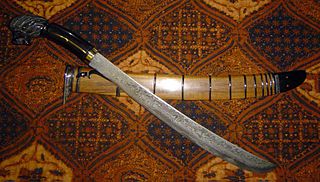
A golok is a cutting tool, similar to a machete, that comes in many variations and is found throughout the Malay archipelago. It is used as an agricultural tool as well as a weapon. The word golok is used in Indonesia and Malaysia. Both in Malaysia and in Indonesia, the term is usually interchangeable with the longer and broader parang. In the Sundanese region of West Java it is known as bedog. In the Philippines, the term gulok, refers to different dagger weapons including the kris.

Pencak silat is an umbrella term for a class of related Indonesian martial arts. In neighbouring countries, the term usually refers to professional competitive silat. It is a full-body fighting form incorporating strikes, grappling, and throwing, in addition to weaponry. Every part of the body is used and subject to attack. Pencak silat was practiced not only for physical defense but also for psychological ends. There are hundreds of different pencak silat styles and schools which tend to focus either on strikes, joint manipulation, weaponry, or some combination thereof.

The rencong is a type of knife originating in Aceh, Indonesia. Originally a fighting weapon, it is most often seen today in the martial art of pencak silat and worn during traditional ceremonies.

Silat is the collective term for a class of indigenous martial arts from the Nusantara and surrounding geocultural areas of Southeast Asia. It is traditionally practised in Brunei, Indonesia, Malaysia, Singapore, Southern Thailand, Southern Philippines and Southern Vietnam. There are hundreds of different styles (aliran) and schools (perguruan) which tend to focus either on strikes, joint manipulation, weaponry, or some combination thereof.
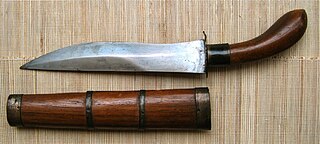
The gunong is a knife from Mindanao and the Visayas islands of the Philippines. In ancient past, it was called bunong by the Tagalog people. It is essentially a diminutive form of the larger kalis or kris. The gunong serves both as a utility knife and as a thrusting weapon used for close quarter fighting—usually as a last defense. It is most often associated with the Maranao, among whom the gunong was traditionally carried by both sexes, although it exists in other cultures throughout Mindanao and the Visayas. The weapon is generally tucked into the back of a waist sash.

A Celurit or Clurit is generally a sickle with a pronounced crescent-blade patterns which curves more than half a circle and a long handle, is widely used for agricultural purposes and also in Pencak Silat. When compared to the Arit, the Celurit is slightly larger.

Listed here are the weapons of pencak silat. The most common are the machete, staff, kris, sickle, spear, and kerambit. Because Southeast Asian society was traditionally based around agriculture, many of these weapons were originally farming tools.
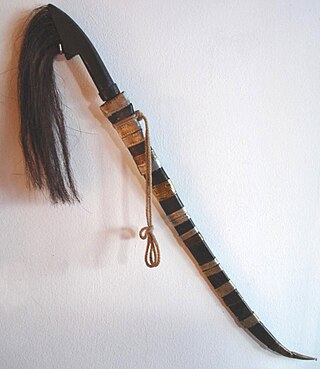
The surik is a traditional sword native to the island of Timor or Nusa Tenggara in wider extent, as well as Sumatra. The first coat of arms of East Timor depicted crossed suriks.

The badik or badek is a knife or dagger developed by the Bugis and Makassar people of southern Sulawesi, Indonesia.
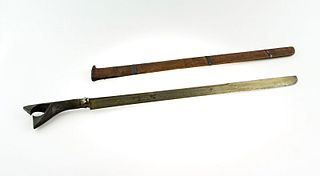
Sikin Panjang is a sword originated from northern Sumatra, Indonesia.

Indonesian martial arts includes a variety of fighting systems native to or developed in the archipelago of Indonesia, both the age-old traditional arts, and the more recently developed hybrid combatives. In the Indonesian language the term bela-diri is used to mean martial art, and in essence the Indonesian fighting arts are meant as one's defence against perceived threat and assault. Other than physical training, they often include spiritual aspects to cultivate inner strength, inner peace and higher psychological ends.

It is quite difficult to define Indonesian art, since the country is immensely diverse. The sprawling archipelago nation consists of 17.000 islands. Around 922 of those permanently inhabited, by over 1,300 ethnic groups, which speak more than 700 living languages.

Pisau raut is a whittling knife that is commonly as a tool to prepare the rattan and other fine carving found throughout the entire Malay archipelago. It is well known as an accompanying knife placed in the same sheath with the mandau, a traditional weapon of the Dayak people.

The Piso Sanalenggam is a type of broad sabre from North Sumatra, Indonesia. This sword is a weapon of war during the times when feuds were frequent among the different Batak groups. Piso Sanalenggam that were made by datu priests from the Dairi Regency region, is used for the preparation of medicine and magical substances.

Tumbok Lada or Tumbuk Lada is a traditional slightly curved dagger that originates in the eastern coast of Sumatra, Indonesia but also found in the western coast of Malay Peninsula, Malaysia.

Dua Lalan is a sword originating from Sulawesi, Indonesia.
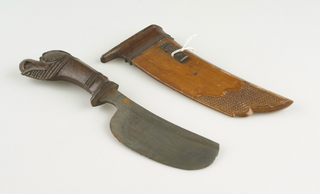
The Bendo is a traditional bladed tool from Java, Indonesia. Betawi people would regard the Bendo as a domestic household tool and sometimes it is also called golok dapur, which means a "kitchen golok".























